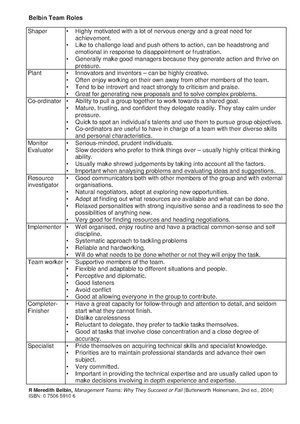Difference between revisions of "Team roles"
(Created page with "Belbin developed his team role theory since 1983. In his book [http://www.amazon.com/Team-Roles-Work-Meredith-Belbin-ebook/dp/B003G5YJS0 'Team Roles at Work'], R. Meredith Bel...") |
(No difference)
|
Revision as of 15:59, 5 January 2017
Belbin developed his team role theory since 1983. In his book 'Team Roles at Work', R. Meredith Belbin (1993) claims that teams are one of the most efficient ways to accomplish tasks and missions. Usually people get a role assigned to them and have to perform the duties and take up the responsibilities that come along with the role. Throughout history the ruler or leader was based on seniority, birth and work was strongly related to gender and race. At the end of the 19th century and the beginning of the 20th century, due to training and education this pattern changed dramatically. People were now hired for their skills and qualifications.
Belbin's approach is that people have a preference for certain roles when working in a team. That means people fit some roles better than other roles. His claim is that a team with people with different social skills and attitudes, thus people with different preferences regarding the role they wish to take up, perform better. Many people search for people that are like themselves, but is better to look for people who are different. Diversity in companies is nowadays considered an asset the human resources department should strive for.
You can find out which team roles fit you best, based on a questionnaire. However, the interpretation of the results requires a skilled (team) coach. Some people's outcome will show a very clear preference. Other people's result may have a less explicit pattern. Definitely the latter group will possibly take up a different role in different situations: at work, in the sports club, etc. They preferences will most likely also vary over time and depend on the team itself.
Take Belbin's Team Roles test. Afterwards read what the different names of the roles mean in the PDF-file below. If you work in a team it is valuable to print out the results and analyse which roles are covered by your team and which roles are under-represented. This implies that your team has to pay special attention to these untreated roles and possibly someone should be assigned to take up this role. You can also learn to take up other roles then your preferences, but it is wise to stick to those roles that are not completely alien to you.
